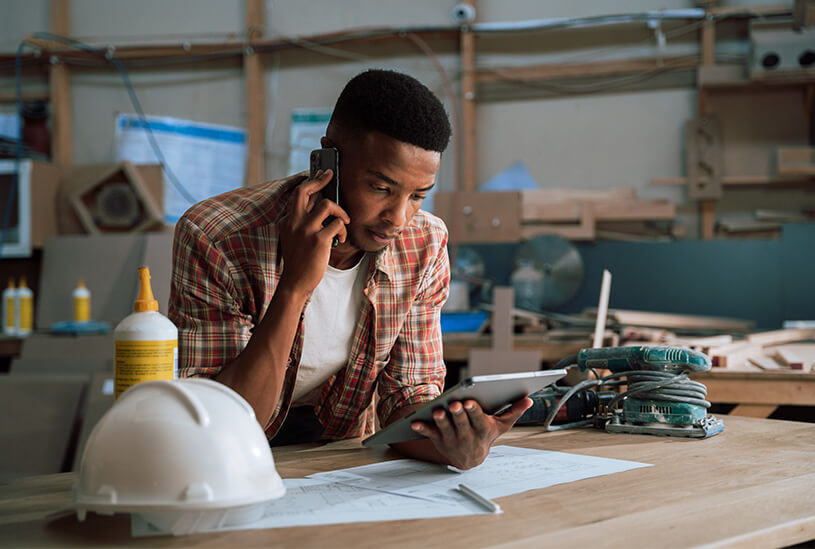If you’re a VAT-registered business that works in construction or with overseas suppliers, you’ll need to know about reverse charge VAT.
A reverse charge means VAT is paid differently to usual, which could have an impact on your cash flow and accounting.
Read on to find out how a VAT reverse charge works and what it means for your business.
What is a VAT reverse charge?
A VAT reverse charge is when the buyer of the service pays for VAT instead of the supplier.
Usually, if a VAT-registered business buys something from another business, VAT will be added to the purchase price. The supplier will then pay the tax to HMRC as part of their VAT return.
With a reverse charge, the supplier doesn’t add VAT to the purchase price and the buyer pays the VAT directly to HMRC.
See examples of how reverse charge VAT works below.
What is a domestic reverse charge for VAT?
The domestic reverse charge (DRC) has been in place since 2021 and is designed to prevent fraud in the construction industry.
It only applies if both the buyer and supplier of services (or subcontractor and main contractor) are VAT-registered. It’s important to note the value of reverse charge services don’t count towards the VAT registration threshold.
Reverse charge VAT applies to services that fall into the standard rate of VAT (20 per cent) and the reduced rate of VAT (five per cent). It doesn’t apply to supplies or services that are exempt or fall into the zero rate of VAT.
The CIS and VAT reverse charge
The DRC applies to most construction businesses that are part of the Construction Industry Scheme (CIS).
Services that fall under the CIS and, as a result, reverse charge VAT include:
- construction, repair, extension, alteration, and demolition of buildings
- decorating or cleaning of buildings during construction
- installation of systems (such as lighting or heating)
Businesses that supply the following services are exempt from the reverse charge system:
- surveying or architecture
- drilling for natural gas or oil
- manufacturers of machinery and utility systems
See a full list of services that are covered by DRC or exempt from it on the government website.
What does reverse charge VAT mean for construction businesses?
The supplier in the transaction will need to provide the buyer with a reverse charge invoice, instead of adding VAT to the cost of the service.
The buyer will then use the reverse charge invoice to calculate and submit a Construction Industry Scheme tax return to HMRC.
Buyers who pay reverse charge VAT are usually able to claim it back as input tax.
Construction businesses affected by the VAT reverse charge system will need to think about how it could affect their cash flow. Although they won’t have to pay VAT upfront, they’ll need time to pay it later when they submit their VAT return.
This article is intended as a guide only. Reverse charge VAT can be complicated so make sure you speak to a professional account or tax expert if you’re unsure of anything.
Domestic VAT reverse example
A small building firm, Stanley & Sons, is hired by property developer Clubhouse Developments to renovate a property.
Both companies are VAT-registered and the works falls under the Construction Industry Scheme, so domestic reverse charge VAT applies:
- Stanley & Sons invoices Clubhouse Developments for the work, but doesn’t include VAT on the price
- the invoice will need to state that the VAT is being reverse charged
- Clubhouse Developments calculates the VAT due on the service and includes this in their own VAT return to HMRC
Reverse charge VAT for businesses with overseas suppliers
The VAT reverse charge also applies when a business buys services or supplies from an overseas business.
As with the domestic charge, the overseas business doesn’t add VAT to their purchase price. Instead, the UK business accounts for the VAT and includes it in their VAT return to HMRC.
VAT reverse example if you work with overseas businesses
A marketing agency in the UK, Clearwater Media, hires an Italian supplier, La Migliore Camicia, to manufacture some merchandise for an upcoming event.
As La Migliore Camicia is based outside of the UK, the VAT will have to be reverse charged:
- La Migliore Camicia invoices Clearwater Media for the work, but doesn’t include VAT on the price
- the invoice will need to state that the VAT is being reverse charged
- Clearwater Media calculates the VAT due on the service and includes this in their own VAT return to HMRC
Read more about how VAT works when you buy goods from overseas businesses.
HMRC reverse charge VAT invoice example
On an invoice where the VAT is being reverse charged, the supplier can refer to the VAT as zero per cent.
The invoice must then include a reference to the fact that the VAT is being reverse charged.
Usually, the invoice will also include the buyer’s VAT number.
Do you have any unanswered questions about reverse charge VAT? Let us know in the comments below.
More small business guides
- How to apply for an EORI number: a guide for businesses
- Rules you need to know if you import or export from the EU
- Construction apprenticeships: a small business guide
- What could the trades skills shortage look like in 2030?
Ready to set up your cover?
As one of the UK’s biggest business insurance providers, we specialise in public liability insurance and protect more trades than anybody else. Why not take a look now and build a quick, tailored quote?
Photograph: Prins Productions/stock.adobe.com
